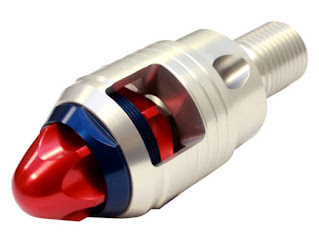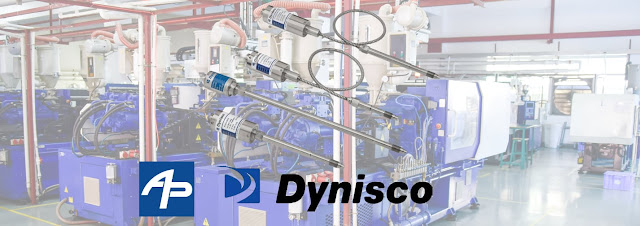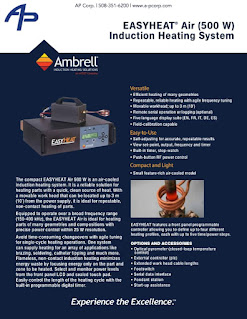A blog discussing sensors and instrumentation. New products, new technologies, and interesting applications. Types of sensors and instruments discussed include: Analyzers, Color Sensors, Displacement Sensors, Flow Sensors, Industrial Weighing, Instrumentation (Data Acquisition), Load Cells & Instrument Hardware. Machine Controls, Pressure Gauges, Pressure Sensors, Sanitary Sensors, Strain Gages, and Temperature Sensors. Courtesy of AP Corp.
Dynisco Cloud Connect™
With the new Dynisco Cloud Connect™ through Microsoft® Azure – you get a single cloud solution that aggregates all your device(s) data into one place that is secure, reliable, easy to share, with 24/7 support.
The Dynisco Cloud Connect can be used for one product or entire global production lines –whether across the street or across the globe giving you easy access to manage data across the cloud, no matter where it lives. This solution is easily expandable and is even compatible with multiple brands and equipment types, from sensors to melt flow indexers to rheometers. With Dynisco Cloud Connect, you can compare and correlate data between facilities and be able to monitor and adjust parameters in real-time, from a mobile device anywhere in the world, whether working in the field, on the production floor, or in the office.
For more information about Dynisco products in New England and Upstate New York, contact AP Corp. Call them at (508) 351-6200 or visit their website at https://a-pcorp.com.
Process Weighing, Web Tension, and Force Control Systems Applications in Pulp and Paper Production
DOWNLOAD THE BLH PULP & PAPER APPLICATIONS GUIDE HERE
Pulp and Paper Applications
- State-of-the-Art Instrument for Weighing and Force Measurement
- Web Tension Measurement Unit
- Dynamic Resultant Force Measurement
- Refiners Position and Pressure Control
- Paper Rolls, Pulpers and Coating Kitchen
Micro-Measurements Strain Gage Instrumentation Catalog
Explore Micro-Measurements complete catalog of data acquisition instruments.
Micro-Measurements offers a comprehensive range of specialty instruments for data acquisition. With Micro-Measurements instruments, you can capture fully corrected, accurate engineering-unit data with minimal effort. Their special-purpose equipment, backed by highly skilled engineers' expertise and knowledge, complements strain gage installation integrity and instrument calibration.
Product Range:
- High-speed data loggers
- Single-channel devices
- Portable indicators
- Multi-channel data acquisitions systems
- High-bandwidth signal conditioners
- Signal conditioning amplifiers
- Embedded analog-to-digital convertors
- Inputs for other commonly used sensors, including load cells, displacement transducers, thermocouples, and accelerometers.
The QSO® Quick Shut-off Valve from Glycon Corporation
A better quick shut-off non-return valve for the Plastics Industry.
Injection molding applications require two important criteria from a non-return valve:- Rapid material shut off for part weight consistency
- A smooth, high-flow profile to prevent material degradation.
The Glycon QSO® valve is the only valve that provides you both. The result is higher quality parts, fewer rejects, improved yield, and a better return on every pound of material you run.
Compared to traditional ball and ring check valves, only the QSO® Quick Shut-off Valve delivers both high flow and raid shut-off. Plastics molders prefer the QSO® because:
- The QSO® ends short shots!
- The QSO® reduces scrap rates
- The QSO® optimize part weight consistency
- The QSO® prevents material degradation
- The QSO®is perfect for filled materials
- The QSO® eliminates need for decompression or “suck back”
- The QSO® maintains smooth material flow path
- The QSO®is designed for long lasting and durable
Which Melt Pressure Sensor Is Good for My Application?
So how do I choose the right melt pressure sensor for my application?
A sensor is defined through the following specifications:
- Pressure Range
- Process connection
- Electrical output and connection
- Capillary configuration (rigid/flexible)
There are more variables come into play, but let's focus on these four since they are the most critical.
Melt Pressure Sensor Pressure Range
Melt Pressure Sensor Process Connection
Melt Pressure Sensor Electrical Output
A pressure sensor is an electro-mechanical device that converts a mechanical effect (pressure deflects a thin piece of metal) into an electrical signal through a strain gauge. The strain gauge changes its resistance by following the deflection of the metal piece. In the simplest case, the strain gauge signal can be used directly to feed a read-out device to display the pressure. In order to accommodate industry-standard equipment, such as process control equipment, manufacturers like Dynisco supplies sensors with different amplified output options such as 4-20mA or 0-10V.
Melt Pressure Sensor Capillary Configuration
A typical pressure sensor has a liquid-filled capillary that connects the process-connection diaphragm (which is deflected by the process pressure) and the measuring diaphragm (where the strain gauge is bonded). This capillary is necessary to create a heat barrier, as the strain gauge cannot withstand the typical process temperatures at plastics processing. Also, the sensor's electronics need to be kept away from heat sources as well as possible. To find a suitable mounting location for the electronics, countless combinations of the rigid stem and flexible connection lengths are available.
Other Considerations in choosing a Melt Pressure Sensor:
- Diaphragm materials
- Diaphragm coatings
- Approvals and certifications
Web Tension Control in Paper Production
BLH Nobel web tension systems comprise off-the-shelf standard modules and electronics, as well as customized systems. BLH Nobel designs force measurement modules according to the customers’ mechanical requirements and forces, ranging in size from just a few Newtons to mega-Newtons. The combination of digital signal amplifiers and stable force transducers means that BLH Nobel systems can handle anything from applications with a low tare and large forces, to those with a large tare and small forces.
For more information about BLH Nobel products in New England, contact AP Corp. Call them at (508) 351-6200 or visit their website at https://a-pcorp.com.
EASYHEAT Induction Heaters from Ambrell Corporation
Flameless, non-contact induction heating minimizes energy waste by focusing energy only on the part and zone to be heated. Select and monitor power levels from the front panel LCD and sealed touch pad. Remote power control is available for employing contact inputs, analog inputs or optional serial data port. Easily control the length of the heating cycle with a built-in programmable digital timer.
Download the Ambrell EASYHEAT® 500 Watt to 10 kW Induction Heater Catalog here.
For more information about Ambrell products in New England, contact AP Corp. Call them at 508-351-6200 or visit their website at https://a-pcorp.com.Melt Processing of Thermoplastics for Extrusion and Injection Molding
Melt Processing of Thermoplastics for Extrusion and Injection Molding Table of Contents:
- Introduction
- Hygroscopic Behavior
- Granule Characteristics
- Thermal Properties and Heat Input Thermal Stability
- Flow Properties
- Thermal Properties and Cooling Crystallization and Shrinkage Molecular Orientation
New Bench Top Series of Shaker Systems from Sentek Dynamics
The BT Series shakers from Sentek Dynamics are designed for demanding vibration test applications. Typical applications included structural analysis, calibration and testing of smaller assemblies. The BT-100 through BT-400 shakers utilize light weight rare earth magnets in lieu of traditional Alnico magnets. The use of these magnets decreases the total shaker mass to a third of similar size system, making these shakers easy to handle and portable.
The systems range in size from 100 N (70 lbf) to 1000 N (224 lbf). Systems 400 N (99 lbf) and smaller are permanent magnet shakers and use lightweight rare earth magnets, making these systems easy to handle and portable. There are three versions of the BT Series of shakers: the BT, BT-M and BT-MTH.
The BT Series is recommended for vibration testing of small assemblies and components. These shakers have armature diameters from 60 mm (2.36 in.) to 120 mm (4.72 in.). The BT-1000 is equipped as standard with Automatic Armature Centering (AAC) and Air-Isolation Feet (AIF).
The BT-M and BT-MTH Series are our modal shakers lines. BT-M will use standard stingers while the BT-MTH is our through-hole version. On the 100 N and 200 N system the BT-MTH offers over double the displacement. The BT-MTH Series allow you to use piano-wire stingers. The BT-1000-M is ideal for the structural and modal analysis of high-mass structures. The addition of ZPR (electronic zero-point regulation and adjustable suspension stiffness) allows the user to pre-load the structure prior to applying a dynamic load.
The new Sentek Dynamics Bench Top and modal exciters are based upon years of practical experience. These systems all exhibit a high lateral stiffness and high force-to-weight ratio. They are specifically designed to help ensure the best possible performance with minimum setup time.
Contact AP Corp. regarding any Sentek Dynamics product in New England and Upstate New York. Call us at (508) 351-6200 or visit our website at https://a-pcorp.com.
Micro-Epsilon Laser Profile Scanners: scanCONTROL LLT3000 and 2500
Micro-Epsilon scanCONTROL LLT3000
Micro-Epsilon scanCONTROL 2500
BLH Nobel KIS Beam Load Cell Technology
About Induction Heating
What is induction heating?
 Induction heating is a fast, efficient, precise, repeatable, non-contact method for heating metals or other electrically-conductive materials . An induction heating system includes an induction power supply which converts line power to an alternating current, delivers it to a workhead and work coil creating an electromagnetic field within the coil. The work piece is placed in the coil where this field induces a current in the work piece, which generates heat in the work piece. The coil, which is water-cooled and cool to the touch, is placed around or adjacent to the work piece. It does not touch the work piece, and the heat is only generated by the induced current flowing in the work piece.
Induction heating is a fast, efficient, precise, repeatable, non-contact method for heating metals or other electrically-conductive materials . An induction heating system includes an induction power supply which converts line power to an alternating current, delivers it to a workhead and work coil creating an electromagnetic field within the coil. The work piece is placed in the coil where this field induces a current in the work piece, which generates heat in the work piece. The coil, which is water-cooled and cool to the touch, is placed around or adjacent to the work piece. It does not touch the work piece, and the heat is only generated by the induced current flowing in the work piece.Induction heating is used in processes where temperatures are as low as 100 oC (212 °F) and as high as 3000 °C (5432 °F). It can be used in brief heating processes that are on for less than half a second and in heating processes that are on for months.
Induction heating is used in domestic and commercial cooking, and in many applications such as melting, heat treating, preheating for welding, brazing, soldering, curing, sealing, shrink fitting in industry, and in research and development.
Learn more about induction heating by downloading the "About Induction Heating Solutions" technical note courtesy of Ambrell Induction Heating Systems.
In-Line Turbidity and Haze Measurement
 |
| Photo 1: Equitech's Retro-Reflection Probe |
 |
| Photo 3: Trend charts of EquiColor Software |
 |
| Photo 2: ICS stainless steel NEMA4 box with touch-screen |
What is a Binocular Strain Gauge Load Cell?
Load Cells for Weighing Vessels in Hot and Vibration Prone Areas
A case in point is a chemical manufacturer with several, existing three cubic meter batching tanks. It was decided the tanks needed modifications to provide more accurate weighing of the individual ingredients. The existing load cells were experiencing errors due to thermal expansion of the vessel, and the resultant side loads from expansion. Additionally there was a problem with vibration in the plant. A better solution was needed, and whatever the solution would be, the customer made it clear the new weighing system must provide system accuracy in the range of ±0.1%.
An approach to deal mechanically with the thermal cycling while using the same type of load cell was discussed. It involved several mechanical modifications that required significant and costly structural changes.
 |
| BLH KIS |
 |
| BLH Controller |
For more information on BLH Nobel products in New England and Upstate New York contact A-P Corp. Call them at (816) 353-6550 or visit them at https://a-pcorp.com.
Coronavirus Update
We at AP Corp. continue to navigate the rapidly changing COVID-19 pandemic. We are closely monitoring the situation and following the guidance available through the Centers for Disease Control (CDC), the World Health Organization (WHO) and state and regional public health authorities. We are committed to the safety of our customers, business partners, and employees.
- Our office locations remain open and the manufacturers of the products we represent are producing products as normal.
- We have transitioned our sales and service staff to work remotely. We are maintaining a limited staff in our main office to support critical functions including shipping, receiving, accounting, and IT.
- While our territory managers will not be making in-person visits for the foreseeable future, we are using phone, fax, email, and tele-conference to continue to provide customer support.
- We will update this statement as the situation changes.
We thank you for your continued business and support. Please stay safe and be well.
New Ransomware Attacks Against Industrial Control Systems (ICS)
Ransomware is malicious software that will lock up data on a computer’s drive, then travel across the network and encrypt other data. The saboteurs will then demand payment in exchange for releasing the data. Whereas industrial control system machines are high-value targets (healthcare is the other high-value target) EKANS is unusual in that the malicious code uses targeted intelligence for control systems to first encrypt the root data (files are encrypted and renamed with random 5-character extension) and then ruin the software processes and hold the data hostage.
EKANS targeted companies and are sent a ransom note with the instruction to pay the ransom in cryptocurrency. There is an email address provided for contact/replies.
Manufacturing plants, power grids, and industrial concerns (such as oil refineries) are all targets of this malicious malware.
Another feature of the EKANS ransomware is it is programed to terminate sixty-four (64) various processes on computers – most of which are ICS specific. This suggests the possibility that the EKANS may also share features similar to the Megacortex ransomware, which first appeared in early 2019. Megacortex relies on a manual method of deployment rather than self propagation ransomware deployment.
It is still unknown whether the EKANS ransomware originated from state-sponsored hackers or via real cybercriminals trying to profit from industrial control system owners. It appears that it may be the latter, based on the most recent analysis of the nature of the ransomware – analysis by Dragos researchers.
It is wise to raise awareness with among everyone who touches your systems and it would be prudent to have someone within your organization (or a consultant) tasked with keeping data security protections current. In addition, it is crucial to have ICS organizations rethink their cybersecurity leadership philosophy. In many organizations, the evangelists for cybersecurity are not equipped to exert influence in the company. Cybersecurity is still treated as a back-office job, but it needs to be treated as priority by the organizational leaders.
Dragos adversary hunters recommend keeping ICS systems segmented from the rest of the network. In this way, if just one Window machine is infected, the virus can’t mobilize to the systems that control the infrastructure. In addition, standard practices such as backups, stored offline, and including the last known good configuration data will somewhat reduce the liability of slow recovery. Guardrails such as improved access and mechanisms for authentication will also help to reduce the risk of these increasingly troubling attacks on ICS systems.
More detailed information can be accessed here:
https://dragos.com/blog/industry-news/ekans-ransomware-and-ics-operations/
Article courtesy of A-P Corporation, a manufacturer’s representative for the leading suppliers of sensors, instrumentation, and induction heating equipment. Providing professional sales engineering services to New England and upstate New York since 1959.



















